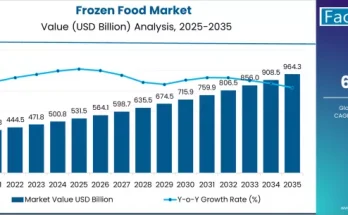Pulses—nutrient-dense legumes such as lentils, chickpeas, beans, and peas—are becoming increasingly vital in the global food system. As the world embraces healthier diets, protein-rich plant foods, and environmentally sustainable agriculture, the pulses market is showing strong momentum. Their role in combating food insecurity, supporting soil fertility, and offering affordable nutrition continues to elevate demand across both developed and emerging economies.
The growing awareness of plant-based proteins and the rising adoption of vegetarian and vegan lifestyles further reinforce the importance of pulses in the global food and nutrition landscape. As a key component of traditional diets across continents, pulses maintain cultural relevance while aligning with modern preferences for clean-label, natural, and minimally processed foods.
Market Overview:
The pulses market includes the production, processing, distribution, and consumption of a variety of legumes used in daily food preparations, packaged foods, animal nutrition, and industrial applications. Known for their versatility, pulses serve as a major protein source in many plant-based dishes and form an essential component of balanced diets.
Key factors driving the pulses market include:
- Rising consumer focus on protein-rich and fiber-rich foods
- Increasing demand for plant-based and meat-alternative ingredients
- Growing recognition of pulses as climate-resilient crops
- Expansion of the global functional food and beverage industry
Pulses require relatively low water, improve soil health through nitrogen fixation, and support sustainable farming practices. These ecological benefits are strengthening their position within agricultural supply chains, making them a preferred crop among producers.
Regional Insights:
Asia-Pacific:
Asia-Pacific represents one of the largest consumers and producers of pulses due to the region’s significant reliance on plant-based diets. Pulses remain a core part of traditional meals, with expanding urban populations and modern lifestyle trends boosting packaged and value-added pulse-based products. Improvements in supply chain efficiency and enhanced agricultural practices continue to support market growth.
North America:
In North America, consumer demand is driven by increasing interest in plant-based proteins and healthier dietary patterns. Pulses are widely used in salads, soups, snacks, and meat-alternative products. The region also plays a major role in global pulse exports, supported by advanced farming technologies and supportive agricultural policies.
Europe:
Europe’s pulses market is driven by rising consumer awareness of sustainable eating and the environmental footprint of food choices. The growth of vegan cuisine, gluten-free diets, and high-protein foods is prompting manufacturers to incorporate pulses into pasta, bakery, beverages, and ready meals. European consumers value ethically sourced, organic, and non-GMO pulse varieties.
Latin America, Middle East & Africa:
Other regions are witnessing increasing adoption due to improving food security initiatives, rising health consciousness, and growing export opportunities. Pulses serve as affordable nutrition, making them essential in regions focusing on balanced diets and cost-effective protein sources.
Key Trends & Forecast:
Several key trends are shaping the future landscape of the pulses market:
- Growing Demand for Plant-Based Protein Alternatives
With consumers shifting toward flexitarian, vegetarian, and vegan diets, pulses are being widely used as primary ingredients in plant-based meat substitutes, protein powders, and fortified foods.
- Expansion of Value-Added Pulse Products
Manufacturers are introducing innovative products such as pulse flours, ready-to-eat snacks, gluten-free pasta, bakery mixes, and beverages incorporating lentils, chickpeas, and peas. These innovations are expanding pulses beyond traditional consumption patterns.
- Rising Popularity of Clean-Label and Natural Foods
Consumers increasingly seek foods free from artificial additives. Pulses meet this need, offering natural protein, minerals, and fiber. Their clean-label appeal is boosting their integration into packaged and health foods.
- Sustainable & Climate-Resilient Farming Practices
Pulses contribute significantly to sustainable agriculture due to their nitrogen-fixing properties and low water requirements. Their role in crop rotation and soil restoration is attracting support from global sustainability initiatives.
- Technological Advancements in Processing & Packaging
Improved milling, dehulling, and processing technologies are enhancing product quality and shelf life. Innovations in packaging are making pulse-based products more convenient and appealing for modern consumers.
- Rising Use in Functional Foods & Nutraceuticals
Pulses are increasingly recognized for their functional health benefits, including support for weight management, digestive health, and metabolic wellness. This is fostering their use in high-nutrition food supplements and specialized diets.
Applications & End-Use Outlook:
Pulses have diverse applications across food, agriculture, nutrition, and industrial sectors.
Food & Beverages:
Pulses are extensively used in household cooking, packaged meals, snacks, bakery products, soups, and ethnic cuisines. Pulse flours are gaining popularity as gluten-free alternatives in breads, noodles, and desserts.
Nutraceuticals & Functional Foods:
Owing to their impressive nutrient profile, pulses are increasingly used in protein supplements, meal replacement powders, energy bars, and health beverages.
Animal Feed:
Pulse by-products such as pulse bran and husk are used in animal feed formulations owing to their protein richness and digestibility.
Agriculture:
Farmers value pulses for crop rotation practices, soil enrichment, and pest-resistant benefits, making them a critical component of sustainable agricultural systems.
Industrial Applications:
Pulses and their extracts are utilized in certain industrial processes, such as biodegradable packaging materials, fermentation, and plant-based ingredient production.
Conclusion:
The pulses market continues to gain prominence as a cornerstone of healthy diets, sustainable farming, and global food security. Their nutritional value, affordability, and low environmental impact make them indispensable in the modern food ecosystem. As consumers increasingly shift toward plant-based and eco-friendly choices, pulses are becoming integral to culinary innovation, agricultural development, and dietary transformation.
With expanding product diversification, technological advancements, and rising awareness of their health and environmental benefits, pulses are poised to remain one of the most influential segments in the global food and agriculture industry. Leveraging market insights can help producers, brands, and stakeholders develop strategies that align with the growing demand for nutritious, sustainable, and versatile food solutions.
Browse Full Report – https://www.factmr.com/report/2247/pulses-market



